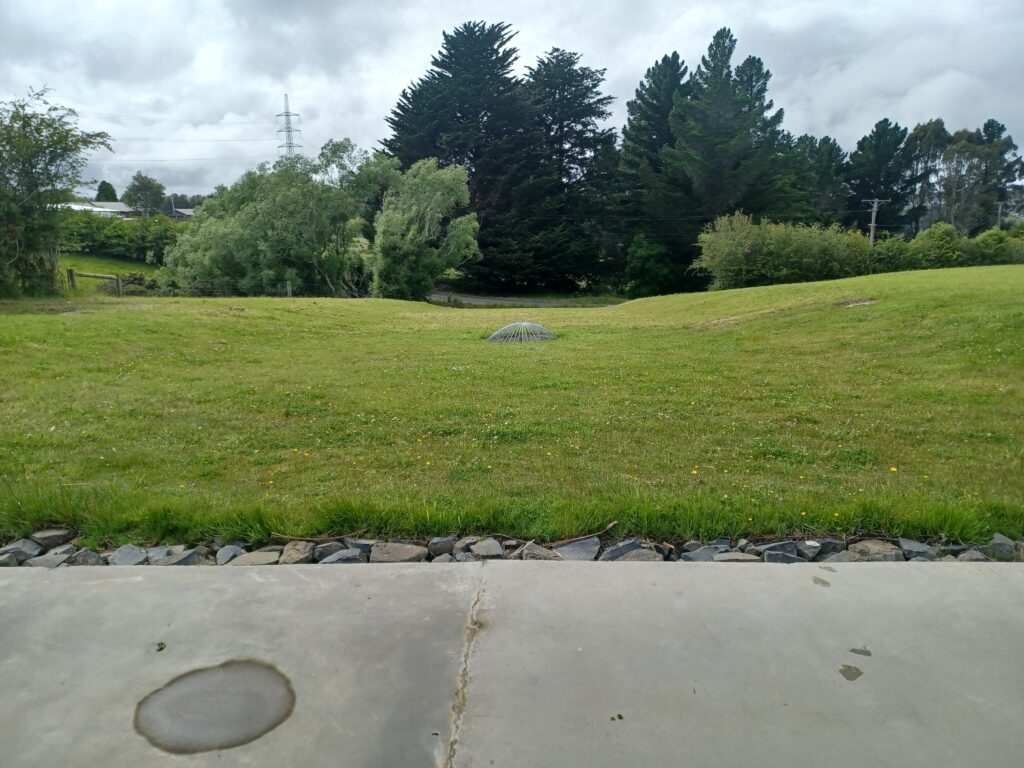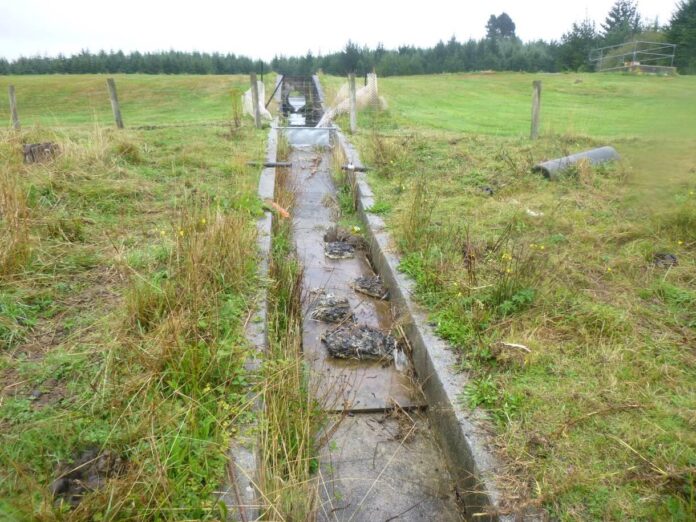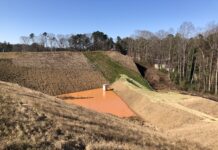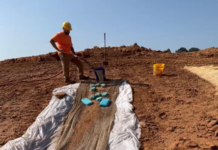Protecting the water supply for a New Zealand community was the goal of a reservoir spillway upgrade in 2019. Originally constructed in the 1880s, erosion and insufficient capacity of the original spill posed a risk to the future operations of the reservoir.
Dunedin is located on the southeast coast of the South Island of New Zealand and is known for its Scottish and Māori heritage.
Nestled in one of the hills above Dunedin is the Southern Reservoir Dam that was originally constructed in the 1880s and is owned and operated by Dunedin City Council, for the purposes of water supply. It has a total reservoir storage volume of approximately 260,000 cubic meters (340,067 cubic yards) at full supply level. Due to the condition of the existing spillway arrangement (Figure 1), it was recommended that a new spill be constructed in a location adjacent to where it currently exists.
An engineering report identified two confirmed dam safety deficiencies:
- The existing service spillway, an appurtenant structure to the dam, has insufficient capacity to safely pass the required Inflow Design Flood. There is also a high risk of blockage, due to the culvert at the upstream end of the spillway.
- Erosion of embankment materials around the existing service spillway location.
The new service spillway has been designed to safely pass the 1:10,000 Annual Exceedance Probability flood, and the new spillway must have a significant increase in capacity from 1 cubic meter per second (35 cubic feet per second) to 8 cubic meters per second (283 cubic feet per second).
Following an options assessment, a reinforced grass-lined spillway was selected as the preferred option. The key basis for this was capital cost versus other options such as concrete or rip rap. The cost of this solution was less than 50% the cost of hard armour, as well as providing a greener engineered solution. A key dam safety consideration for a grassed-line spillway is potential soil erodibility. Specifically, backward erosion (headcutting) leading to an undermining of the spillway control structure and an uncontrolled release of the reservoir. This meant the grassed spillway needed to be reinforced.
The five fundamentals of successful revegetation and erosion control was adopted and executed:
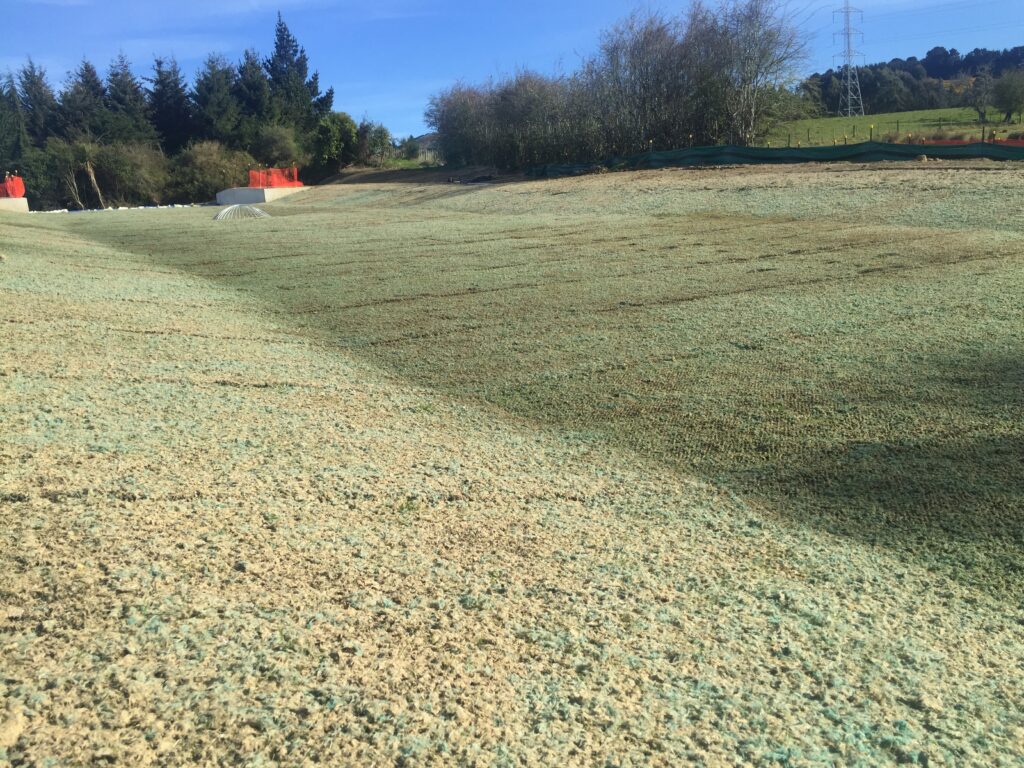
Fundamental #1: Understand Your Substrate.
A soil test was conducted with the soil that was to be used for the spillway. The results showed low levels of phosphorus and potassium. However, all other levels were in the ideal range to sustain vegetation. A fertiliser was selected to increase the levels that were deficient, to be applied with the hydraulic erosion control product (HECP) as well as the seed.
Fundamental #2: Species Selection.
Due to the Dunedin climate, only cool season grasses were selected. The average high temperature for Dunedin is 17°Celsius (63°Fahrenheit) in the summer months and 10°Celsius (50°Fahrenheit) in the winter months. Three of the four cultivars were bred within a 300 kilometre (186 mile) radius of where the project is located.
- Colosseum perennial ryegrass (Lolium perenne) is a New Zealand bred turf ryegrass that provides exceptional winter growth and is proven to germinate down to soil temperatures of 5°Celsius (4°Fahrenheit) as well as being high in endophyte which helps to resist insect damage.
- Governors creeping red fescue (Festuca rubra) was selected from naturalised fine fescue on the Banks Peninsula in Canterbury.
- Arrowtown Browntop (Agrostis capillaris) was selected due to the plant having been bred from plant collections located in Arrowtown, Central Otago.
With the above three cultivars and the additional of a Silhouette chewings fescue (Fesctua rubra subsp. commutata) it meant the seed blend would be climatically adaptable to the project.
The blend consisted of (percentage measurements by weight):
- 50% Colosseum perennial ryegrass (Lolium perenne).
- 23% Governors creeping red fescue (Festuca rubra).
- 22% Silhouette chewings fescue (Fesctua rubra subsp. commutata).
- 5% Arrowtown browntop (Agrostis capillaris).
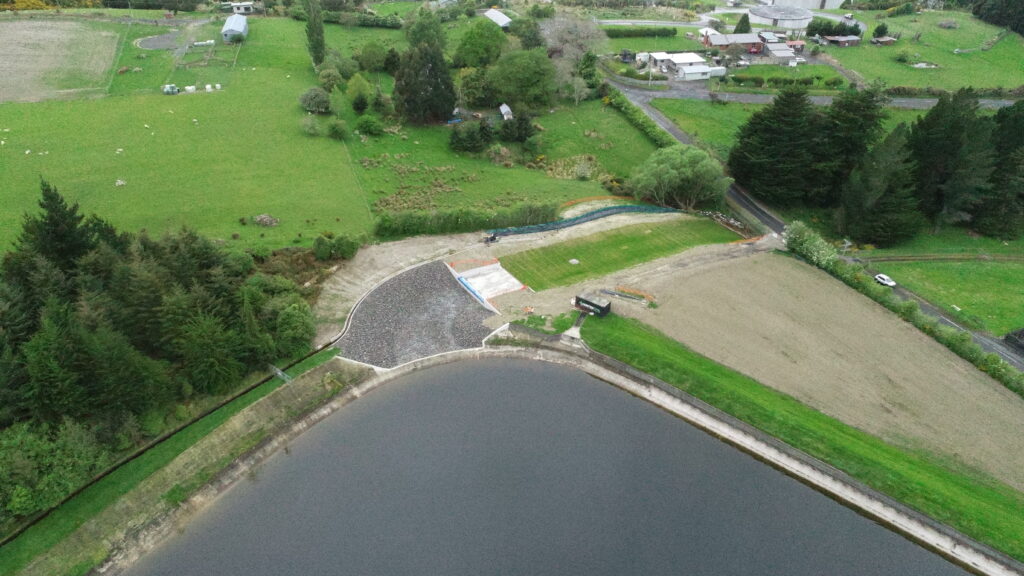
Fundamental #3: Erosion Control Material.
A hybrid system consisting of a turf reinforcement mat (TRM) that is infilled with a hydraulic erosion control product was selected. The system offered a more aesthetically pleasing and environmentally superior means of protecting high-discharge waterways than the likes of concrete or riprap. The system begins with a TRM that provides a permanent, lofty and open matrix. It is then hydraulically infilled with a highly engineered wood fibre mulch (Figure 2) as a growth medium to intimately bond soil and seeds while accelerating growth and providing instant erosion control.
Fundamental #4: Correct Installation.
It was critical to ensure that the product was installed to manufacturers guidelines as well as to use a contractor with experience applying the hydraulically applied erosion control product was utilised.
The TRM was installed, then followed by:
- Hydraulic erosion control product at 3,900 kg/ha (3,500 lb/ac).
- Specified seed blend sown at 400 kg/ha (356 lb/ac).
- Di-ammonium phosphate at 200 kg/ha (178 lb/ac).
Fundamental #5: Follow-up Inspections and Maintenance Practices.
The site was regularly inspected to ensure the success of establishment (Figures 3, 4). There was a fertiliser recommendation eight weeks after installation to encourage the speed of establishment due to the time frame that the spillway was required to be operational. This consisted of an application of a controlled released NPK granular fertiliser which had 70% upfront nitrogen and 30% slow-release nitrogen.
Once construction was completed and full vegetation was established, the project was then handed back to the Dunedin City Council’s operation department for maintenance such as mowing. The new upgraded spillway has been operational now for three years since its completion in 2019.
About the Expert
Joe Johnson is the business development manager for PGG Wrightson Turf in New Zealand. He has been in the erosion and sediment control industry for 12 years and currently sits on the IECA Australasian Chapter’s Board of Directors as the Treasurer.
